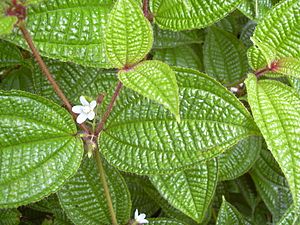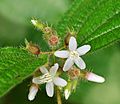Clidemia hirta facts for kids
Quick facts for kids Clidemia hirta |
|
|---|---|
 |
|
| Scientific classification | |
| Genus: |
Clidemia
|
| Species: |
hirta
|
Clidemia hirta, often called soapbush or Koster's curse, is a type of perennial shrub. This means it's a woody plant that lives for more than two years. It's known as an invasive plant in many warm, tropical parts of the world. When a plant is invasive, it spreads quickly and causes serious problems for local plants and ecosystems.
Contents
- What Does Koster's Curse Look Like?
- Where Does Koster's Curse Grow?
- How Does Koster's Curse Live and Spread?
- Why Is It Called "Koster's Curse"?
- Why Is Koster's Curse a Problem?
- How Can We Control Koster's Curse?
- Rules and Laws About Koster's Curse
- Where Koster's Curse Is Found in Australia
- Other Names for Koster's Curse
- Images for kids
- See also
What Does Koster's Curse Look Like?
Clidemia hirta is a bushy shrub that grows between 0.5 and 3 meters (about 1.5 to 10 feet) tall. Sometimes, it can even reach 5 meters (16 feet) in height! It grows taller in shady places than in sunny, open areas.
Stems and Leaves
The younger stems of the plant are round and covered with stiff, brown or reddish hairs. Its leaves grow in pairs on opposite sides of the stem. They are oval-shaped with pointed tips and have slightly toothed edges. The top of the leaves has a few hairs, while the bottom and edges are much hairier. The leaves also look a bit wrinkled and have five clear veins running from the base to the tip.
Flowers and Fruits
The flowers of Koster's curse grow in small groups at the ends of the branches. Each flower has five white, or sometimes light pink, petals. The base of the flower is cup-shaped and covered with bristly, sticky hairs. The flowers also have five tiny sepals (leaf-like parts that protect the bud) and five unique stamens that look like claws.
The plant produces small, round berries that are dark blue, purple, or black. Each berry is packed with over 100 tiny, light brown seeds. These berries are also covered in stiff hairs, especially when they are young.
Uses of the Plant
Even though it's an invasive plant, Clidemia hirta has been used as an ornamental plant. This means people have grown it for decoration in gardens or as houseplants because of its appearance.
Where Does Koster's Curse Grow?
This plant originally comes from the American Neotropics, which includes areas from Mexico down to Paraguay and the Caribbean islands. However, it has spread widely across Southern Asia, East Africa, and even parts of Australia.
Spread to Hawaii and Sri Lanka
Clidemia hirta arrived in Hawaii in the 1940s. By 1978, it had taken over more than 90,000 hectares (about 222,000 acres) of land on Oahu. It was first seen on the Big Island in 1972. In Sri Lanka, it causes big problems in wet forests, especially by growing in open spots and stopping native plants from growing.
Preferred Habitats
This species thrives in warm, humid tropical climates. It can invade both areas that have been disturbed (like roadsides or cleared land) and untouched natural habitats. You might find it in wet pastures, open grasslands, farms, roadsides, open woodlands, riverbanks, forest edges, and even rainforests.
How Does Koster's Curse Live and Spread?
The plant's height can vary from 1 to 5 meters (3 to 16 feet) depending on where it grows.
Berries and Seeds
The berries are purple-brown to blue-black and can be up to 8 millimeters (0.3 inches) long. They taste a bit like a strong blueberry. Each fruit holds more than 700 tiny seeds, which are only about 0.5 millimeters (0.02 inches) across. The plant can flower and produce fruit all year long if there's enough moisture. A large plant can make over 1,000 fruits in a single year, meaning it can produce 700,000 seeds!
Seed Dispersal
Birds, wild pigs, other animals, and even humans help spread the seeds. Sheep do not eat the plant. The tannin found inside the fruits is poisonous to goats. Studies in Australia show that the seeds can stay alive in the soil for at least 12 years, waiting for the right conditions to grow.
Human Uses and Health
While the tannin in the fruit is not harmful to humans, the full edibility of the berry hasn't been completely explored. A tasty syrup can be made from the fruit. This syrup has a beautiful indigo blue color and can be used to improve the taste of teas, like yerba mate, by removing bitterness. In Brazil, this plant is also used in traditional medicine to treat certain skin infections.
Why Is It Called "Koster's Curse"?
The word hirta in the plant's scientific name means "bristly" in Latin, referring to its hairy parts.
The common name "Koster's curse" is used in places where the plant is a harmful weed, like Hawaii. Koster was a person who, between 1880 and 1886, accidentally brought Clidemia hirta seeds to Fiji. This happened through coffee nursery plants. The plant's problematic nature was first noticed around 1920. At first, it was just called "the curse" because of the damage it caused to coconut farms. Later, its name became a pattern for other invasive plants, like "Ellington's curse" in Fiji or "McConnel's curse" in Australia.
Why Is Koster's Curse a Problem?
Even though Clidemia hirta is native to tropical America, it has become an invasive species in Southern Asia, East Africa, and many islands with warm climates, such as Hawaii and Australia.
Harm to Ecosystems
Koster's curse can grow into very thick patches. These dense growths can smother and choke out plantations, pastures, and native plants. This means the local plants can't get enough sunlight or nutrients, and they die.
How It Spreads Quickly
Disturbances to the land are key to how Koster's curse gets started and spreads. Things like wildfires, landslides, strong winds, and even soil being dug up by animals (like pigs) help this weed take over. In its native home, the plants usually only grow in open areas and become dominant about a year after a disturbance, such as in areas cleared by slash-and-burn farming. In Hawaii, all new areas where Koster's curse appears are along the open edges of trails or other disturbed spots.
Threat to Native Species
In Hawaii, Koster's curse is replacing the native plants that used to dominate the forests. This puts the native species at risk of extinction. In other places, like the Comoros Archipelago, La Réunion, the Seychelles, and Mauritius, it is considered one of the most serious invasive species.
How Can We Control Koster's Curse?
To keep this weed out of an area, the main goal should be to prevent and reduce any disturbances to the land.
Methods of Control
One way to control it is by manually pulling the plants out of the ground. Sometimes, this is combined with using herbicide (weed killer) applications. However, these methods are often only temporary.
A tiny insect called the thrips species Liothrips urichi, which comes from Trinidad, is being used to control Clidemia hirta naturally. This method, called biological control, was first tried in Fiji in 1930.
Controlling wild pig populations is also a good way to reduce the spread of Clidemia hirta. This is because when pigs dig up the ground, it helps the plant get established. Even though sheep can help control most weeds on farms, they will not eat Clidemia hirta.
For a long time, there wasn't a very effective chemical spray to control Clidemia hirta. However, some studies have shown that certain chemicals, like triclopyr, can kill the plant. Also, a special type of mycoherbicide (a weed killer made from fungi) has been found to be effective against it.
Rules and Laws About Koster's Curse
Clidemia hirta has been named one of the "World's Worst" invaders by a group called the IUCN Invasive Species Specialist Group. It is also listed as a harmful weed in Queensland and the Northern Territories in Australia, and in Hawaii. However, it is not listed as a harmful weed by the governments in Kenya, Tanzania, and Uganda.
Where Koster's Curse Is Found in Australia
In 2001, an outbreak of Koster's curse was found in Julatten, near Mount Molloy, Queensland. This outbreak threatens to spread into the nearby Mount Lewis National Park and Mowbray National Park. Local community groups are working together to control the plant in Julatten.
In 2016, another outbreak was found in Wooroonooran National Park.
Koster's curse has the potential to spread very quickly across many parts of Australia where the conditions are right. This includes the Northern Territory, northern New South Wales, and much of north-east Queensland. In New South Wales, Australia, there's even a special phone number for people to call if they see the plant.
Other Names for Koster's Curse
Here are some other scientific names that have been used for Clidemia hirta:
- Clidemia benthamiana
- Clidemia cognata
- Clidemia crenata
- Clidemia elegans (Aubl.) D. Don 1823
- Clidemia leptocada
- Clidemia pauciflora
- Dancera hirta
- Leandra fimbriata
- Melastoma anhaga
- Melastoma aristatum
- Melastoma elegans
- Melastoma rustica
- Staphidium elegans
- Staphidium hostmanii
Images for kids
See also
 In Spanish: Cordobán peludo para niños
In Spanish: Cordobán peludo para niños






